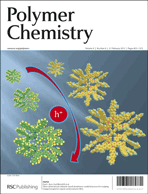Reducing polyazomethine to poly(N-phenylbenzylamine) with near infrared electrochromic, fluorescence and photovoltaic properties†
Abstract
A novel series of solution-processable near-infrared (NIR) electrochromic aromatic poly(N-phenylbenzylamines) (RPAMs) have been synthesized by the reduction of polyazomethines (PAMs). The RPAMs were characterized by


 Please wait while we load your content...
Please wait while we load your content...